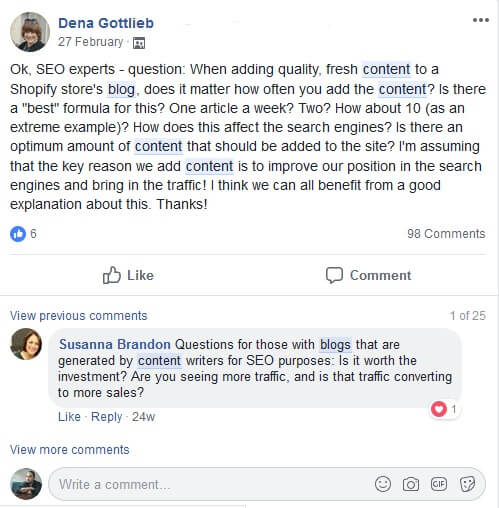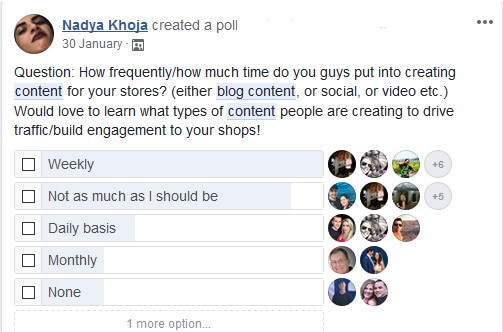Ecommerce Content Marketing: An Interview With Elise Dopson
- Jun-10-2018
- Harris Sid
- 0 comments
Not many e-commerce store owners; especially the ones using Shopify, are aware about the potential of blogging for their stores. Do they create buyers guides? Top 10 lists? Seasonal trendy things? How does that all fit in with their overall revenue strategy? Not many have the answer.

And that’s why I sat down with content marketing veteran Elise Dopson to chat about exactly what kind of content works in the e-commerce industry and how you can leverage it to increase your sales and brand value. Here’s our Q&A in full:
Harris: For our readers, tell us a bit about yourself and what you do.
Elise: I’m a B2B content writer for Saas and eCommerce companies. In simpler terms: I write awesome content for companies who sell stuff online.
I’ve worked with companies like Hubspot, Referral Candy and Copper (previously known as ProsperWorks) to create data-driven content for their blog, and had my writing published on sites like Social Media Examiner, Shopify, and SEMrush.
…You could say I get around.
Harris: In your experience, what have been the most common mistakes most e-commerce newcomers make in terms of marketing?
Elise: They don’t get to know their audience first.
Spending three hours writing an awesome blog post is all well and good, but it won’t deliver the results you’re hoping for if it’s not written with your audience in mind.
For example: If you’re an eCommerce company selling women’s sneakers, you might assume a customer wants more information on your sizing. But, after researching and conducting one-on-one reviews with people who’ve previously purchased from you, you might learn that your audience is actually struggling to pair your shoes with their outfits.
Shying away from this feedback—or avoiding it altogether—wouldn’t help you to find this, and so your entire content marketing strategy could be a total waste of time.
Harris: Why is it important for a regular joe running a Shopify store to invest in content marketing strategy?
Elise: Because content is online communication. In a brick and mortar store, it’s uncommon for 100% of your customers to avoid speaking to a sales rep.
Sales reps don’t exist online—unless you’re using live chat (but let’s save that discussion for another day).
You know what does exist? Content.
Acting as your eCommerce store’s main method of conversation (without actually doing the talking), it’s your route to creating personal connections with people who visit your online store.
If you’re not creating content, that’s impossible.
Harris: What kind of content works best for an e-commerce website?
Elise: Oooh, tough question! I think it varies dramatically.
Blog posts should be a given for any eCommerce website, but only if they’re long-form and comprehensive. Publishing 500-word pieces “for the sake of it” doesn’t really work—at least not when it comes to ranking that article in Google.
The best example I could find for this was Net a Porter’s online journal. Their blog—named “Mr Porter’s Weekly Journal”—publishes regular content their readers would love, without obviously selling their products. That’s key; the best marketing doesn’t feel like marketing.
Other types of content—such as eBooks or whitepapers—are another type of critical content, in my opinion. That’s because they often go above and beyond with detail, and usually need a customer to hand over their email address before gaining access. (That helps with further email marketing.)
BigCommerce’s eBook is another great example. Sharing a gated advanced guide to eCommerce SEO, they’re providing in-depth material to win-over a customer, and make their brand #1 choice when their audience is ready to get started.
There are other content formats, such as:
- Infographics
- Videos
- Podcasts
- Case studies
…that can pay-off when including them in your eCommerce content strategy. My advice would be to focus on one, nail it, and then repeat with another.
Harris: What would be your checklist for researching competitors that have successful content strategies that you can look to for inspiration?
Elise: I’ve got a four-step process:
- Survey previous customers and find out which blogs they like to read in the same industry.
- Use Buzzsumo to find the most popular content in your niche, based on total engagements. (You can do this by URL, too—great if you already got a bunch of blogs from step #1.)
- Find what makes them so great. Do they all follow a how-to format? Are they all 2,000+ words? Does the conclusion include a CTA? Do they all have 1,000+ social shares?
- Copy it; adding your own spin.
This might be a short checklist, but the best eCommerce content marketing strategies come directly from customer feedback.
Make that your priority: Creating the content your audience is asking for.
Harris: What are the key factors in determining content goals and their ROI for an e-commerce website? How does one set up performance measurements for these?
Elise: Tracking the ROI of content marketing is hard because it’s a long-term process; people might read a blog post of yours and purchase six months later. However, I’ve found the easiest way to track this is by looking at conversion paths in Google Analytics. What route did people take before landing on your purchase confirmation page? Work your way back to their first interaction with your site. If 40% of those are blog posts, you’re doing something right.
For short-term measurements, you could factor email marketing into the mix. Include a lead magnet (such as an eBook or free guide) in each piece of content, and tag people who’ve signed up with the label “blog post”. Send regular emails and see how many of the people with that tag convert.
Harris: I’ve seen ebooks and guides used often for leads. What are some good examples of lead magnets for an e-commerce store in, say, the fashion or home decor space?
Elise: AppFolio, a property management software company who sell their products online, worked with a market research company to produce an eBook titled, “U.S. Apartment Trends: What’s Happening in Your City?“. Their ideal customers are U.S.-based, have an interest in property, and want to know whether property prices are rising or falling in their city—making it a perfect piece of long-form content for their audience to consume. This gated eBook does a fantastic job at combining gated lead generation content with interactive content, too. The landing page has clickable features which share a handful of stats from the full report which gets their audience engaged pre-registration.
What’s the process for creating stories that attach to an e-commerce brand and its products? How can smaller scale e-commerce stores create these stories?
The “why”—tell people the story behind why you made the products or services that you’re selling. It’s all well and good to write a story that isn’t related to your product and publish it on your blog, but that runs the risk of people thinking, “What has this got to do with their business?”.
Clothing brand Nasty Gal is a great example of how eCommerce brands can focus on the why to create stories. The About page of their website tells the story of how founder Sophia Amoruso built the clothing empire—back in 2006 in her ex-boyfriend’s apartment.
Stories build personal connections. Don’t underestimate the power of answering the “why”, but avoid telling stories that don’t give value to your audience.
As a general rule: If it’s not interesting or relevant, leave it out.
Harris: Is there a process to buillding a story like this? What are the ingredients that you need to complete a compelling story that sets your brand in its place?
Elise: Generally, the best use of storytelling in content marketing comes when you’re sharing something that caters to your audience’s pain point. Whether you’re basing the content around a case study or mentioning how the tactics you’re sharing have worked for a previous client, it gives a brief background on how your product or service works—with data to back it up. For example: If you’re an eCommerce business that sells accounting software, write a piece like “How to Use Software to Manage (and Predict) Your Small Business’ Cash Flow” and tell the story of how a previous customer did it successfully. What problems were they facing beforehand? How did they solve it? What success have they seen off the back of it? Answers to all three of those questions are relevant, interesting, and appealing to the person you’re writing to.
Harris: What’s the best way for an e-commerce site to get press and blog coverage/backlinks and referrals?
Elise: Sign up to HARO and watch for their emails like a hawk. A list of journalists (who’re looking for third-party sources) send requests three times a day. Submitting your own response—whether it be advice, a tip or a story—could land you a link.
This is a tip I’ve seen success from first-hand. After responding to a request from a writer at Fit Small Business, I landed coverage by contributing my advice.
I got a backlink from a highly authoritative site in my industry, and because I shared my advice, I proved my knowledge. In return, my own site’s Domain Authority had increased, and I saw a handful of awesome enquiries come through my website.
Talk about a win-win!
Harris: What’s your recommended learning resource for e-commerce content marketing?
Elise: Shopify has a bunch of cool stuff on eCommerce content marketing, as do BigCommerce. Both of those sites have taught me tons of tips I’d never even thought of. Keeping up with them has helped me to pass new trends, tips and tricks onto my eCommerce clients.
I share a few of those tips on my blog, like this post on harnessing the power of psychology in content marketing. (I’d love to see you over there!)
Harris: What the most challenging project/client you worked for in this space? How did you handle it?
Elise: I recently worked with one of my clients—a Saas company in the SEO space—to create a round-up of small business SEO tips. It took hours to find 17 specialists, reach out to them and get a quote, but I’m so proud of how it turned out!
I think collaboration is key in eCommerce, and round-ups are a great way to collaborate on content marketing, especially when you’re working with influencers.
By showing your audience that you’ve got your finger on the pulse and “in there” with trusted people in the industry, it can bring the same benefits as influencer marketing—just on a smaller scale.
Harris: Lastly, any advice for struggling e-commerce entrepreneurs out there?
Elise: It sounds cliche, but don’t stop!
Content marketing takes a huge amount of time, effort (and sometimes cash) to get off the ground—you could be waiting months to see results. That doesn’t mean they’re not coming soon, though.
Harris: Thanks for your time, Elise!
You can check out Elise’s blog at http://elisedopson.co.uk/
